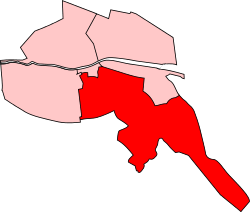| Dublin St Stephen's Green |
|---|
Former Borough constituency
for the House of Commons |
|

Dublin St Stephen's Green constituency within Dublin, as it existed from 1885 to 1918. |
|

Dublin within Ireland. Map utilises the modern administrative boundaries. |
| 1885–1922 |
|---|
| Number of members |
1 |
|---|
| Created from |
Dublin |
|---|
St Stephen's Green, a division of Dublin, was a UK parliamentary constituency in Ireland. It returned one Member of Parliament (MP) to the British House of Commons 1885–1922.
Prior to the 1885 general election, the city was the undivided two member Dublin City constituency. In 1885, Dublin was divided into four constituencies: the St Stephen's Green, Dublin College Green, Dublin Harbour and Dublin St Patrick's constituencies.
In 1918, the city was allocated seven seats: in addition to the four existing constituencies, the new divisions were Dublin Clontarf, Dublin St James's and Dublin St Michan's.
From the dissolution of 1922, the area was no longer represented in the UK Parliament.
Boundaries
This constituency comprised parts of the south-east of the city of Dublin, including the area containing its namesake; St Stephen's Green.
Politics
Dublin St Stephen's Green gave Sinn Féin almost two-thirds of its votes. The minority was fairly evenly divided between the Irish Parliamentary Party and the Unionists.
In common with other Sinn Féiners, elected in 1918, the Deputy did not take his seat at Westminster but instead participated in the revolutionary Dáil Éireann.
Members of Parliament
Key to parties: APN Anti-Parnellite Nationalist (Irish Parliamentary Party), Ind N Independent Nationalist, Ind N-H Independent Nationalist (supporter of Timothy Healy), Lab Irish Labour Party, N Nationalist (Irish Parliamentary Party), PN Parnellite Nationalist (Irish Parliamentary Party), SF Sinn Féin, U Unionist, LU Liberal Unionist, L Liberal Party.
Elections
This constituency elected its MP using the first past the post electoral system.
Elections in the 1910s
Elections in the 1900s
Elections in the 1890s
Elections in the 1880s
See also
References
- ↑ Campbell was defeated 'very largely because of the actions of die-hard unionists' - see D.George Boyce, Alan O'Day (editors) 'Defenders of the Union: A Survey of British and Irish Unionism Since 1801', page 123
- ↑ 'Unionist abstentionism helped to unseat Campbell' - see Alvin Jackson, 'Ireland 1798-1998: War, Peace and Beyond',page 226
- ↑ 'He lost the seat partly because middle-class Protestants, like their Catholic counterparts, were involved in a widespread flight to the suburbs, where the air was cleaner and the rates lower.' - Pádraig Yeates, 'A City in Wartime – Dublin 1914–1918: The Easter Rising 1916',
- ↑ '[This] by-election ... revealed how deep the divisions in unionist ranks ran, but it was also a harbinger of the future. Senior figures within the Unionist Party were not inclined to contest the seat, especially as the new nationalist-backed ‘independent’ candidate, Laurence Waldron, was a stockbroker and former unionist who would be a moderating influence in the House of Commons. Several leading business figures, including Sir William Goulding, chairman of the Great
Southern and Western Railway, and Lord Iveagh, head of the Guinness dynasty, resigned from the Unionist Representative Association in protest at a grass-roots revolt that led to the association supporting the candidacy of Norris Godard, a Crown solicitor. It was a foolish nomination, as Godard could stand only by relinquishing his lucrative government post, which he declined to do. The former Unionist MP for the constituency, James Campbell KC, was available to stand and had the added advantage of being wealthy enough to finance his own campaign, but the Unionist Representative Association would not have him. There followed an unseemly row about the rival candidacies of another lawyer, C. L. Matheson, and Michael McCarthy, a colourful renegade nationalist from Cork who was popular with militant unionists because of his books denouncing the evils of Catholicism. Matheson secured the nomination but, as expected, was defeated by Waldron.' - Pádraig Yeates, 'A City in Wartime – Dublin 1914–1918: The Easter Rising 1916',
- ↑ http://www.ark.ac.uk/elections/h1918.htm
- ↑ General Election: 14 December 1918 – Dublin St Stephen's, ElectionsIreland.org
- 1 2 3 4 5 6 7 8 9 Walker, B. M. Parliamentary Election Results in Ireland, 1801-1922. Royal Irish Academy. p. 346.
- ↑ The Constitutional Year Book, 1904, published by Conservative Central Office, page 194 (218 in web page)
- ↑ Walker, Brian Mercer (1978). Parliamentary Election Results in Ireland, 1801-1922. Dublin: Royal Irish Academy. p. 142. ISBN 0 901714 12 7.
- ↑ Walker, B. M. Parliamentary Election Results in Ireland, 1801-1922. Royal Irish Academy. p. 138.
- ↑ Walker, B. M. Parliamentary Election Results in Ireland, 1801-1922. Royal Irish Academy. p. 132.
External links
Parliamentary constituencies in Dublin City and County |
|---|
|
Parliament of Ireland
to 1800 | |
|---|
|
Westminster 1801–1922
and First Dáil 1918 | |
|---|
|
Dáil Éireann
1918–present | |
|---|
|
European Parliament
1979–present | |
|---|
|
Constituencies in Ireland by county
|
- Carlow
- Cavan
- Clare
- Cork
- Donegal
- Dublin
- Galway
- Kerry
- Kildare
- Kilkenny
- Laois
- Leitrim
- Limerick
- Longford
- Louth
- Mayo
- Meath
- Monaghan
- Offaly
- Roscommon
- Sligo
- Tipperary
- Waterford
- Westmeath
- Wexford
- Wicklow
|
|---|
| |
- Antrim
- Armagh
- Down
- Fermanagh
- Londonderry
- Tyrone
|
|---|
|

